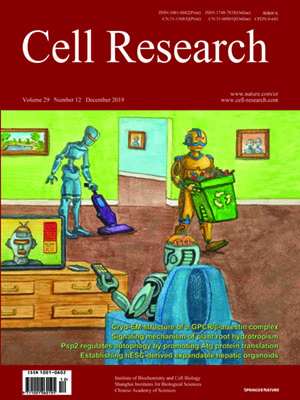
Volume 29, No 12, Dec 2019
ISSN: 1001-0602
EISSN: 1748-7838 2018
impact factor 17.848*
(Clarivate Analytics, 2019)
Volume 29 Issue 12, December 2019: 1039-1041
LETTERS TO THE EDITOR
Cryo-EM structure of human lysosomal cobalamin exporter ABCD4
Da Xu1, Zhang Feng 1, Wen-Tao Hou1, Yong-Liang Jiang1,Liang Wang1, Linfeng Sun 1,2 , Cong-Zhao Zhou 1 and Yuxing Chen1
1Hefei National Laboratory for Physical Sciences at the Microscale and School of Life Sciences, University of Science and Technology of China, 230027 Hefei, Anhui, China and 2CAS Centre for Excellence in Molecular Cell Science, University of Science and Technology of China, 230027 Hefei, Anhui, China
These authors contributed equally: Da Xu, Zhang Feng.
Correspondence: Linfeng Sun (sunlf17@ustc.edu.cn) or CongZhaoZhou (zcz@ustc.edu.cn) or Yuxing Chen (cyxing@ustc.edu.cn)
Dear Editor,
Cobalamin, also known as vitamin B12, can only be biosynthesized by certain bacteria and archaea. As an essential nutrient for humans, it should be obtained from daily food.1 Exogenous cobalamin is taken up by the cell through an endocytosis process, then released into the lysosome as a free form, and finally pumped out to the cytosol for utilization.2 The human ATP-binding cassette (ABC) transporter ABCD4 localized on lysosomal membrane is indispensable for the efflux of cobalamin from lysosome to cytosol.3 Mutations in ABCD4 gene may result in cobalamin deficiency and inborn diseases. The patients suffer from combined symptoms: hypotonia, lethargy, poor feeding, bone marrow suppression, macrocytic anemia, and heart defects.3 However, the absence of the structure of human ABCD4 limits our understanding of the molecular mechanism of pathogenesis.
https://doi.org/10.1038/s41422-019-0222-z
FULL TEXT | PDF
Browse 1160


